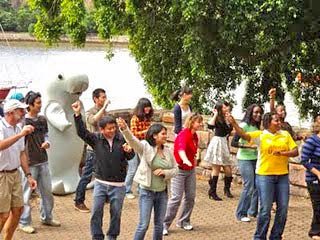Brisbane 2011: Living with floods and dancing with dugongs
Adrian Jones · Dr. Bill Dennison
Thursday 7th July 2011
5.30 - 7.00pm *followed by light refreshments
The Long Room Customs House 399 Queen Street, Brisbane
RSVP here

The 2011 Queensland floods have provided a 'learning moment' for Queenslanders.
As councils, businesses and families rebuild from the devastating floods, it is important to reflect on how to live in a climate characterized by prolonged droughts punctuated by extreme events.
The 2011 Brisbane floods were the eighth largest since 1840, and even more pronounced floods are a certainty for the future. Since the last major flood in 1974, Brisbane and Southeast Queensland residents have embraced the waterways, with festivals, bikeways, transport, parks , and clean ups focused on the waterways. The juxtaposition of this waterways embrace and a severe La Nina climatic shift has contributed to the large scale impact of the 2011 floods.
There are global examples of societal responses to floods that can serve as models for Queensland. In Queensland, there is an opportunity for better planning, catchment management and strategic infrastructure investments to reduce the impact of future floods.
One hidden consequence of the January floods was the increased turbidity of Moreton Bay. Dugongs, a conservation icon of Queensland, rely on seagrasses that grow in shallow waters of eastern Moreton Bay. Seagrass require adequate light to survive and turbid flood waters can result in seagrass mortality and associated dugong starvation (e.g. Hervey Bay, 2002). Fortunately, eastern Moreton Bay seagrasses are relatively unaffected by flooding and dugongs should have an adequate food source to survive. However, dugongs in other regions are likely to be affected by floods and various other factors compromise their future status. So that Queenslanders can continue to dance with dugongs, learning to live with floods is of paramount importance.

Dr. Bill Dennison is a Professor of Marine Science and Vice President for Science Applications at the University of Maryland Center for Environmental Science (UMCES).
About the author
Adrian Jones

Adrian has over 25 years experience in software development. He loves the challenge of building interactive data visualization tools, from the database to the front-end. He has worked with a wide range of businesses, universities, governmental, and non-governmental organizations around the world.
He also enjoys contributing to open source software and avidly follows the latest web and app development tools and frameworks.

